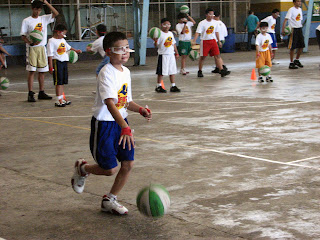Youth Ball
Feb. 8, 2009
Youth Ball
At the start of the year, we talked about the need for a total approach to basketball. By “total,” we were referring to the need to touch base with all age groups of the sport, giving them equal attention in the form of basketball activities.
At the top of the echelon are all the activities at the professional level. The PBA is the only show in town for this. Right below this are the activities of the semi-pro leagues, ranging from the PBL to the Liga Pilipinas and the smaller local commercial leagues that each city usually has. The collegiate and high school scenes come next. The UAAP and NCAA are the top players here while we have the CESAFI taking care of this in Cebu.
But the biggest hole that was always empty in the past was the age group below the juniors level. We are referring to the player 16 years old and below. This also includes the 12 and 10 year age groups. It was only in 2008 that Cebu was able to get a taste of almost a year-long calendar of activities for players in this age group. The Milo BEST SBP/Passerelle basketball tournament has been a fixture in the scene for the past two decades but this was good for only six weeks a year. Then came the Futures Basketball League (FBL) and the Cebu Youth Basketball League. The FBL is played between November and December while the CYBL is played February to early March. With this set up, the job to cover all bases is almost done. The only period of the year that is left vacant for this age group is the summer.
The CYBL kicked off its second season yesterday with a total of 26 teams signing up in three different age groups. After starting out with 12 teams in 2008, the league doubled overnight and added a younger age group to the lot. The “oldest” players belong to the 16-Under division which is for players born in 1993, 1994 and 1995. Each team is composed of a maximum of seven players born 1993, a minimum of six players born 1994 and a minimum of three players born in 1995. The Tropang Growee 13-Under division is for players born in 1996, 1997 and 1998 with a 9-3-3 player breakdown. The Tropang Growee 10-Under division is for players born in 1990, 2000 or younger.
 Noel Salgado and Ian Paz of Growee join the team captains of the Tropang Growee 10-Under age group in a Pledge of Unity.
Noel Salgado and Ian Paz of Growee join the team captains of the Tropang Growee 10-Under age group in a Pledge of Unity.
Competition is expected to be tight in the 16-Under Division-A where Cebu’s best of the 16-Under division are bunched up. Defending champion is the University of San Carlos (USC) South Campus, but expected to be right behind them are the University of Cebu (UC), Sacred Heart School-Jesuit (SHSJ), Don Bosco College-A, University of Southern Philippines Foundation (USPF) and the USC North-A. The league put all the strongest teams together to give them the highest level of competition where every game will be tough and competitive. A Division-B was set up for the relatively weaker teams whose basketball programs are still being developed. Leading the pack is the Cebu Institute of Technology (CIT)/Hoop It Up team. Salazar Colleges & School of Institute of Technology (SCSIT), SHSJ-B, PAREF Springdale, USJR, Don Bosco College-B, USC North-B, and Bradford Christian School.
Like their counterparts in the older division, the Tropang Growee 13-Under Division-A features the strongest teams of 13-year old boys (or younger). Defending their championship is USC North. They will be challenged by SHS-J, rookie team Royal Oaks Int’l School, USC South and Don Bosco College-A. Playing in the Tropang Growee 13-Under Division-B are USJR/Ave Maria Sanctuary, Southwestern University, Don Bosco College-B and USC North-B.
The youngest cagers who provide the most entertaining and liveliest games are featured in the Tropang Growee 10-Under age group. Playing here are PAREF Springdale, USC South, Royal Oaks, Don Bosco College and SHSJ. Their games are much shorter than their “kuya’s” but these are filled with fun and hard work.
The most admirable part about youth basketball is that you get to see the game played at its purest form. The young kids go at it with nothing but basketball in their minds. They’re out there to enjoy the game that they’ve learned to love, and match their competitive play against boys of the same age from other schools. They make new friends, build team bonding and represent their schools. There’s practically no money involved here. In fact, parents have to spend just to give their children a chance to play in the tournament. But the bottom line is that everyone has fun: players, coaches and the parents.
Basketball in its purest form. Youth basketball.


Comments